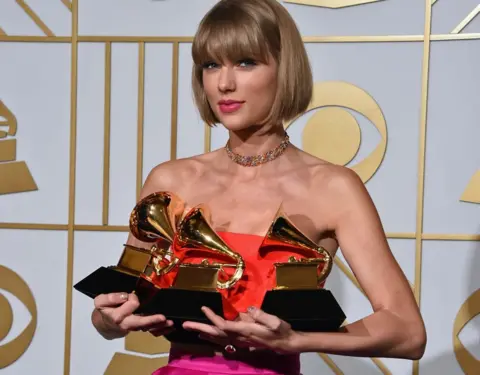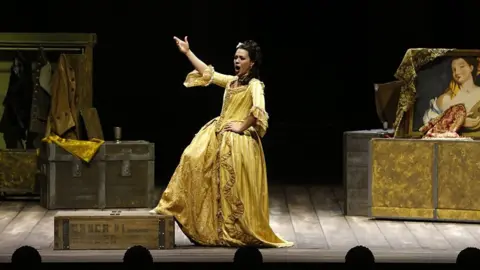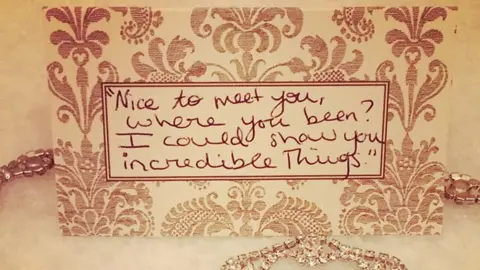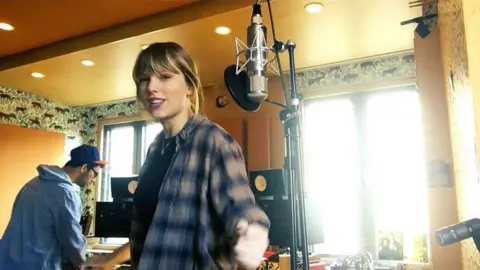Why does Taylor Swift write so many one-note melodies?
Taylor Swift has dozens of melodies that centre on a single note. BBC Music reporter Mark Savage finds out why.
It's easy to get distracted by her celebrity, but Taylor Swift is a once-in-a-generation songwriter.
From the very beginning, she's displayed a knack for melody and storytelling that most artists never master.
Take, for example, her first US number one, Our Song.
Written for a high school talent show, it's a fairly typical tale of teenage romance until the final lines: "I grabbed a pen / And an old napkin / And I wrote down our song."
That's smart, self-assured songwriting for someone who wasn't old enough to vote. Notably, the lyrics insert the musician directly into the narrative - something she developed into a tried and tested trope.
But Our Song also establishes another of Taylor's trademarks: The one-note melody.
These static vocal lines, where she sings at one pitch for a sustained period, crop up on all of her her albums - and increase in frequency when she switches lanes from country to pop.
You can hear it on all four songs she's released ahead of her new record, Reputation, which comes out this Friday. It's most apparent on the lead single, Look What You Made Me Do, where the entire chorus is delivered in a sinister monotone.
But it's less of a cop-out than you might think, and here's why.
 Getty Images
Getty ImagesTaylor Swift's career is built on being accessible. She might have 10 Grammy awards, but she recently invited loyal fans to an album playback at her oceanfront mansion in Rhode Island. In 2008, when she was 18 years old, she accompanied another fan, Whit Wright, to his prom in Alabama. She regularly delivers handwritten notes and gift packages to her Instagram followers.
Repetitive melodies that centre around a single note are part of that appeal. They emphasise her relatability by mimicking the cadence of speech.
It helps that her lyrics are effortlessly conversational and vernacular. "We are never, ever getting back together" is a clumsy song title but it makes perfect sense in Taylor's brand of teen-speak. The impression is that you're hanging out with a friend, chatting about boys (and it's almost always about boys).
Taylor uses the device most often in verses, shifting the chords beneath her voice to give the melody a sense of movement, in the same way that moving a light around the room casts different shadows.
When the chorus soars up the musical scale, it's like a rush of energy. The emotional highs become even higher. And, as I am not the first to point out, she has a flair for melodrama.
 Getty Images
Getty ImagesTaylor didn't invent these one-note melodies, of course. Gregorian chant, one of the earliest recorded forms of Western music, was predominantly monotone.
"A lot of that had to do with understanding the text - because this is religious text and they want people to understand the words that they're singing," said musicologist Scott Interrante in a podcast on the phenomenon of one-note melodies.
"That's important to think about in our modern pop songs," he added. "It might have a lot to do with the words".
Let's scrub out the word "might". Taylor really, really wants us to pay attention to her lyrics.
"I wouldn't be a singer if I weren't a songwriter," she told Billboard in 2014. "I have no interest in singing someone else's words."
 Instagram / @taylorswift
Instagram / @taylorswiftIf you believe the tabloids, she spends most of her time warbling about famous ex-boyfriends and feuds with fellow pop stars - but if you pay attention, Swift's catalogue is full of deft lyrical minutiae.
In fact, she has the rare ability to tell a whole story in the space of a sentence:
- "She wears short skirts / I wear t-shirts / She's cheer captain / And I'm on the bleachers" (You Belong With Me)
- "We're dancing round the kitchen in the refrigerator light" (All Too Well)
- "I never saw you coming/ And I'll never be the same" (State of Grace)
- "Darling, I'm a nightmare dressed like a daydream" (Blank Space)
- "Remember when you hit the brakes too soon? / Twenty stitches in a hospital room" (Out Of The Woods)
That last one is particularly interesting. The car accident was real, and Taylor sings the (one-note) melody with uncommon urgency over a turbulent backing track.
"I put it in the song knowing it was an evocative lyric," she told NPR in 2014. "And it was almost like this very strange, subtle clue to the media that they don't know everything that happened in that relationship, and they don't know everything that happens in my life, and I can have something really major and traumatic happen to me and they don't know about it."
 Getty Images
Getty ImagesOn this year's Look What You Made Me Do, she uses the one-note melody in another way - to convey anger and defiance.
The target here is Kanye West, who stage-crashed her acceptance speech at the 2009 MTV Video Music Awards and has dogged her career ever since.
"I don't like your little games," she spits, "The role you made me play / Of the fool / No, I don't like you."
Her delivery is clipped and defensive. The conversational tone is replaced by a threat. (Incidentally, that's probably why the song took such a battering in the media: Bitter Taylor isn't as appealing as unlucky-in-love-but-shaking-it-off Taylor.)
Another of Taylor's key traits is to shout key lines for emphasis: "We never go OUT OF STYLE"; "Are we in the clear yet, IN THE CLEAR YET? GOOD!"; "All you had to do was STAY (STAY) STAY (STAY)".
Again, she's using rhetorical tricks to drive home her point - and by doing so, she's taking her place in the pop pantheon.
Songwriters like John Lennon and Morrissey, who place equal emphasis on their lyrics, also tend to utilise one-note melodies. And then there's rap, whose rhythmic ebb and flow exerts an increasingly strong gravitational pull on pop writers.
In fact, static melodies are cropping up all over the place, on Dua Lipa's New Rules, Post Malone's Rockstar, and Khalid's Young Dumb & Broke.
 Instagram / @taylorswift
Instagram / @taylorswiftNone of this is to suggest that Taylor is incapable of writing a melody. Of her new tracks, the love song Gorgeous is both the most heartfelt and the most traditionally "songy".
But her masterpiece is a song called Ronan - a little-known charity single, released in 2012. It was written about Ronan Thompson, a four-year-old boy who died of a rare form of cancer.
After reading a blog written by the boy's mother, Maya Thompson, Taylor turned her words into a song: "I remember your bare feet, down the hallway / I remember your little laugh / Race cars on the kitchen floor, plastic dinosaurs / I love you to the moon and back."
In other hands, it could have been saccharine and exploitative. It isn't. Taylor's delicate delivery, and the sorrowful contours of her melody are simply devastating.
If you ever had any doubts, Ronan settles it: Taylor Swift is anything but a one-note pop star.

Follow us on Facebook, on Twitter @BBCNewsEnts, or on Instagram at bbcnewsents. If you have a story suggestion email entertainment.news@bbc.co.uk.

